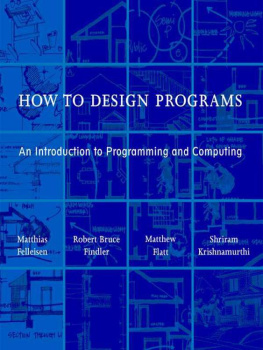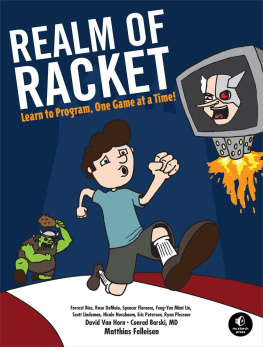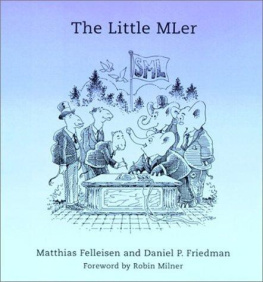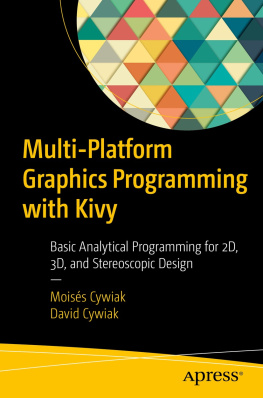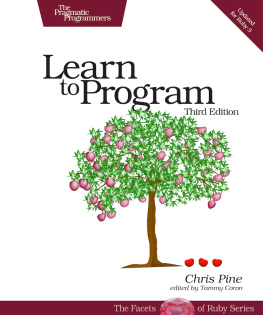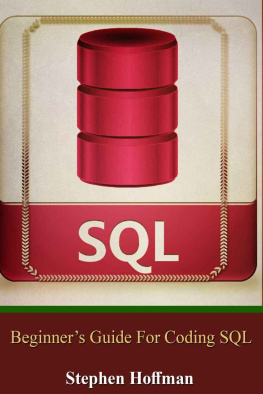How to Design Programs
How to Design Programs
An Introduction to Programming and Computing
Matthias Felleisen
Robert Bruce Findler
Matthew Flatt
Shriram Krishnamurthi

Third printing, 2002
2001 Massachusetts Institute of Technology
Illustrations 2000 Torrey Butzer
All rights reserved. No part of this book may be reproduced in any form by any electronic or mechanical means (including photocopying, recording, or information storage and retrieval) without permission in writing from the publisher.
Library of Congress Cataloging-in-Publication Data
How to design programs: an introduction to programming and computing / Matthias Felleisen, Robert Bruce Findler, Matthew Flatt, Shriram Krishnamurthi; chapter art by Torrey Butzer
p. cm.
Includes index.
ISBN 0-262-06218-6 (hc.: alk. paper)
1. Computer Programming. 2. Electronic data processing.
QA76.6 .H697 2001
005.12dc21
00-048169
Contents
Contents
List of Figures
Preface
Why Everyone Should Learn to Program
Design Recipes
The Choice of Scheme and DrScheme
The Parts of the Book
Acknowledgments
I Processing Simple Forms of Data
1 Students, Teachers, and Computers
2 Numbers, Expressions, Simple Programs
2.1 Numbers and Arithmetic
2.2 Variables and Programs
2.3 Word Problems
2.4 Errors
2.5 Designing Programs
3 Programs are Function Plus Variable Definitions
3.1 Composing Functions
3.2 Variable Definitions
3.3 Finger Exercises on Composing Functions
4 Conditional Expressions and Functions
4.1 Booleans and Relations
4.2 Functions that Test Conditions
4.3 Conditionals and Conditional Functions
4.4 Designing Conditional Functions
5.1 Finger Exercises with Symbols
6 Compound Data, Part 1: Structures
6.1 Structures
6.2 Extended Exercise: Drawing Simple Pictures
6.3 Structure Definitions
6.4 Data Definitions
6.5 Designing Functions for Compound Data
6.6 Extended Exercise: Moving Circles and Rectangles
6.7 Extended Exercise: Hangman
7 The Varieties of Data
7.1 Mixing and Distinguishing Data
7.2 Designing Functions for Mixed Data
7.3 Composing Functions, Revisited
7.4 Extended Exercise: Moving Shapes
7.5 Input Errors
Intermezzo 1: Syntax and Semantics
The Scheme Vocabulary
The Scheme Grammar
The Meaning of Scheme
Errors
Boolean Expressions
Variable Definitions
Structure Definitions
II Processing Arbitrarily Large Data
9 Compound Data, Part 2: Lists
9.1 Lists
9.2 Data Definitions for Lists of Arbitrary Length
9.3 Processing Lists of Arbitrary Length
9.4 Designing Functions for Self-Referential Data Definitions
9.5 More on Processing Simple Lists
10.1 Functions that Produce Lists
10.2 Lists that Contain Structures
10.3 Extended Exercise: Moving Pictures
11 Natural Numbers
11.1 Defining Natural Numbers
11.2 Processing Natural Numbers of Arbitrary Size
11.3 Extended Exercise: Creating Lists, Testing Functions
11.4 Alternative Data Definitions for Natural Numbers
11.5 More on the Nature of Natural Numbers
12 Composing Functions, Revisited Again
12.1 Designing Complex Programs
12.2 Recursive Auxiliary Functions
12.3 Generalizing Problems, Generalizing Functions
12.4 Extended Exercise: Rearranging Words
Intermezzo 2: List Abbreviations
III More on Processing Arbitrarily Large Data
14 More Self-referential Data Definitions
14.1 Structures in Structures
14.2 Extended Exercise: Binary Search Trees
14.3 Lists in Lists
14.4 Extended Exercise: Evaluating Scheme
15 Mutually Referential Data Definitions
15.1 Lists of Structures, Lists in Structures
15.2 Designing Functions for Mutually Referential Definitions
15.3 Extended Exercise: More on Web Pages
16 Development through Iterative Refinement
16.1 Data Analysis
16.2 Defining Data Classes and Refining Them
16.3 Refining Functions and Programs
17.1 Processing Two Lists Simultaneously: Case 1
17.2 Processing Two Lists Simultaneously: Case 2
17.3 Processing Two Lists Simultaneously: Case 3
17.4 Function Simplification
17.5 Designing Functions that Consume Two Complex Inputs
17.6 Exercises on Processing Two Complex Inputs
17.7 Extended Exercise: Evaluating Scheme, Part 2
17.8 Equality and Testing
Intermezzo 3: Local Definitions and Lexical Scope
Organizing Programs with local
Lexical Scope and Block Structure
IV Abstracting Designs
19 Similarities in Definitions
19.1 Similarities in Functions
19.2 Similarities in Data Definitions
20 Functions are Values
20.1 Syntax and Semantics
20.2 Contracts for Abstract and Polymorphic Functions
21 Designing Abstractions from Examples
21.1 Abstracting from Examples
21.2 Finger Exercises with Abstract List Functions
21.3 Abstraction and a Single Point of Control
21.4 Extended Exercise: Moving Pictures, Again
21.5 Note: Designing Abstractions from Templates
22 Designing Abstractions with First-Class Functions
22.1 Functions that Produce Functions
22.2 Designing Abstractions with Functions-as-Values
22.3 A First Look at Graphical User Interfaces
23.1 Sequences and Series
23.2 Arithmetic Sequences and Series
23.3 Geometric Sequences and Series
23.4 The Area Under a Function
23.5 The Slope of a Function
Intermezzo 4: Defining Functions on the Fly
V Generative Recursion
25 A New Form of Recursion
25.1 Modeling a Ball on a Table
25.2 Sorting Quickly
26 Designing Algorithms
26.1 Termination
26.2 Structural versus Generative Recursion
26.3 Making Choices
27 Variations on a Theme
27.1 Fractals
27.2 From Files to Lines, from Lists to Lists of Lists
27.3 Binary Search
27.4 Newtons Method
27.5 Extended Exercise: Gaussian Elimination
28 Algorithms that Backtrack
28.1 Traversing Graphs
28.2 Extended Exercise: Checking (on) Queens
Intermezzo 5: The Cost of Computing and Vectors
Concrete Time, Abstract Time
The Definition of on the Order of
A First Look at Vectors
30 The Loss of Knowledge
30.1 A Problem with Structural Processing
30.2 A Problem with Generative Recursion
31 Designing Accumulator-Style Functions
31.1 Recognizing the Need for an Accumulator
31.2 Accumulator-Style Functions
31.3 Transforming Functions into Accumulator-Style
32 More Uses of Accumulation
32.1 Extended Exercise: Accumulators on Trees
32.2 Extended Exercise: Missionaries and Cannibals
32.3 Extended Exercise: Board Solitaire
Intermezzo 6: The Nature of Inexact Numbers
Fixed-size Number Arithmetic

